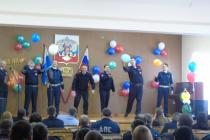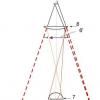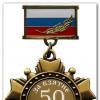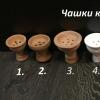Nuclear power plant (NPP)
power plant in which atomic (nuclear) energy is converted into electrical energy. The power generator at a nuclear power plant is a nuclear reactor (see. Nuclear reactor). The heat that is released in the reactor as a result of the chain reaction of fission of the nuclei of some heavy elements is then converted into electricity, just as in conventional thermal power plants. Unlike thermal power plants operating on fossil fuels, nuclear power plants operate on nuclear fuel (See nuclear fuel) (mainly 233 U, 235 U. 239 Pu). When dividing 1 G uranium or plutonium isotopes released 22,500 kW h, which is equivalent to the energy contained in 2800 kg conditional fuel. It has been established that the world's energy resources of nuclear fuel (uranium, plutonium, etc.) significantly exceed the energy resources of natural fossil fuel reserves (oil, coal, natural gas, etc.). This opens up broad prospects for meeting the rapidly growing demand for fuel. In addition, it is necessary to take into account the ever-increasing volume of consumption of coal and oil for technological purposes of the world economy. chemical industry, which is becoming a serious competitor to thermal power plants. Despite the discovery of new deposits of organic fuel and the improvement of methods for its production, there is a tendency in the world to attribute an increase in its cost. This creates the most difficult conditions for countries with limited reserves of fossil fuels. There is an obvious need for the rapid development of nuclear energy, which already occupies a prominent place in the energy balance of a number of industrial countries of the world. The world's first nuclear power plant for pilot purposes ( rice. 1
) with a power of 5 MW was launched in the USSR on June 27, 1954 in the city of Obninsk. Prior to this, the energy of the atomic nucleus was used mainly for military purposes. The launch of the first nuclear power plant marked the opening of a new direction in energy, which was recognized at the 1st International Scientific and Technical Conference on the Peaceful Uses of Atomic Energy (August 1955, Geneva). In 1958, the first stage of the Siberian NPP was put into operation with a capacity of 100 MW(full design capacity 600 MW). In the same year, the construction of the Beloyarsk industrial nuclear power plant began, and on April 26, 1964, the generator of the 1st stage (unit with a capacity of 100 MW) gave current to the Sverdlovsk power system, the 2nd unit with a capacity of 200 MW commissioned in October 1967. Distinctive feature Beloyarsk NPP - superheating of steam (until the required parameters are obtained) directly in a nuclear reactor, which made it possible to use conventional modern turbines with almost no modifications. In September 1964, Unit 1 of the Novovoronezh NPP was put into operation with a capacity of 210 MW Cost price 1 kWh electricity (the most important economic indicator operation of any power plant) at this nuclear power plant systematically decreased: it amounted to 1.24 kopecks. in 1965, 1.22 kopecks. in 1966, 1.18 kop. in 1967, 0.94 kop. in 1968. The first unit of the Novovoronezh NPP was built not only for industrial use, but also as a demonstration facility to show the possibilities and advantages of nuclear energy, the reliability and safety of NPP operation. In November 1965, a nuclear power plant with a pressurized water reactor went into operation in Melekess, Ulyanovsk Region.
"boiling" type with a capacity of 50 MW, the reactor is assembled according to a single-circuit scheme, which facilitates the layout of the station. In December 1969, the second unit of the Novovoronezh NPP was put into operation (350 MW).
Abroad, the first nuclear power plant for industrial use with a capacity of 46 MW was put into operation in 1956 at Calder Hall (England). A year later, a nuclear power plant with a capacity of 60 MW in Shippingport (USA). A schematic diagram of a nuclear power plant with a water-cooled nuclear reactor is shown in rice. 2
. The heat released in the core (See Core) of reactor 1 is taken off by water (coolant (See Coolant)) of the 1st circuit, which is pumped through the reactor by a circulation pump 2.
Heated water from the reactor enters the heat exchanger (steam generator) 3,
where it transfers the heat received in the reactor to the water of the 2nd circuit. Water from the 2nd circuit evaporates in the steam generator, and the resulting steam enters the turbine 4.
Most often, 4 types of thermal neutron reactors are used at nuclear power plants: 1) water-cooled reactors with ordinary water as a moderator and coolant; 2) graphite-water with water coolant and graphite moderator; 3) heavy water with a water coolant and heavy water as a moderator; 4) graphite-gas with gas coolant and graphite moderator. The choice of the predominantly used type of reactor is determined mainly by the accumulated experience in reactor construction, as well as the availability of the necessary industrial equipment, raw material reserves, etc. In the USSR, mainly graphite-water and pressurized water reactors are being built. At US nuclear power plants, pressurized water reactors are most widely used. Graphite-gas reactors are used in England. IN nuclear power Canada is dominated by nuclear power plants with heavy water reactors. Depending on the type and state of aggregation of the coolant, one or another thermodynamic cycle of nuclear power plants is created. The choice of the upper temperature limit of the thermodynamic cycle is determined by the maximum allowable temperature of the claddings of fuel elements containing nuclear fuel, the allowable temperature of the nuclear fuel itself, and also by the properties of the heat transfer medium adopted for a given type of reactor. At nuclear power plants, the thermal reactor of which is cooled by water, low-temperature steam cycles are usually used. Gas-cooled reactors allow the use of relatively more economical steam cycles with increased initial pressure and temperature. The thermal scheme of the NPP in these two cases is performed as a 2-circuit one: the coolant circulates in the 1st circuit, the 2nd circuit is steam-water. In reactors with boiling water or high-temperature gas coolant, a single-loop thermal NPP is possible. In boiling water reactors, water boils in the core, the resulting steam-water mixture is separated, and saturated steam is sent either directly to the turbine or previously returned to the core for overheating ( rice. 3
). In high-temperature graphite-gas reactors, it is possible to use a conventional gas turbine cycle. The reactor in this case acts as a combustion chamber. During the operation of the reactor, the concentration of fissile isotopes in nuclear fuel gradually decreases, i.e., the fuel elements burn out. Therefore, over time, they are replaced with fresh ones. Nuclear fuel is reloaded using remote-controlled mechanisms and devices. Spent fuel rods are transferred to the spent fuel pool and then sent for processing. The reactor and its supporting systems include: the reactor itself with biological protection (See Biological protection), heat exchanger and, pumps or blower units that circulate the coolant; pipelines and fittings of the circulation circuit; devices for reloading nuclear fuel; special systems ventilation, emergency cooling, etc. Depending on the design, the reactors have distinctive features: in pressurized reactors (See Tank Reactor) the fuel rods and the moderator are located inside the vessel, which carries the full pressure of the coolant; in channel reactors (See Channel Reactor) Fuel elements cooled by a coolant are installed in special pipes-channels penetrating the moderator enclosed in a thin-walled casing. Such reactors are used in the USSR (Siberian, Beloyarsk nuclear power plants, etc.). To protect NPP personnel from radiation exposure, the reactor is surrounded by biological protection, the main material for which are concrete, water, and serpentine sand. The reactor circuit equipment must be completely sealed. A system is provided for monitoring the places of possible leakage of the coolant, measures are taken so that the appearance of leaks and breaks in the circuit does not lead to radioactive emissions and pollution of the NPP premises and the surrounding area. The reactor circuit equipment is usually installed in sealed boxes, which are separated from the rest of the NPP premises by biological protection and are not serviced during reactor operation. Radioactive air and a small amount of coolant vapors, due to the presence of leaks from the circuit, are removed from the unattended NPP premises by a special ventilation system, in which purification filters and holding gas holders are provided to exclude the possibility of atmospheric pollution. The dosimetric control service monitors the compliance with the radiation safety rules by the NPP personnel. In case of accidents in the reactor cooling system, in order to prevent overheating and leakage of fuel rod claddings, a rapid (within a few seconds) suppression of the nuclear reaction is provided; emergency system cooling system has independent power sources. The presence of biological protection, special ventilation and emergency cooling systems and a dosimetric control service allows you to completely secure service staff NPP from harmful effects radioactive exposure. The equipment of the NPP machine room is similar to the equipment of the TPP machine room. A distinctive feature of most nuclear power plants is the use of steam of relatively low parameters, saturated or slightly superheated. At the same time, in order to exclude erosion damage to the blades of the last stages of the turbine by particles of moisture contained in the steam, separators are installed in the turbine. Sometimes it is necessary to use remote separators and reheaters of steam. Due to the fact that the coolant and the impurities contained in it are activated when passing through the reactor core, the design of the turbine hall equipment and the cooling system of the turbine condenser of single-loop NPPs should completely exclude the possibility of coolant leakage. At double-circuit NPPs with high steam parameters, such requirements are not imposed on the equipment of the turbine hall. The specific requirements for the layout of NPP equipment include: the minimum possible length of communications associated with radioactive media, increased rigidity of the foundations and load-bearing structures of the reactor, and reliable organization of ventilation of the premises. On rice.
shows a section of the main building of the Beloyarsk NPP with a channel graphite-water reactor. The reactor hall contains: a reactor with biological protection, spare fuel rods and control equipment. The nuclear power plant is arranged according to the block principle reactor - turbine. Turbine generators and systems serving them are located in the engine room. Between the engine and reactor halls are placed auxiliary equipment and station control systems. The cost-effectiveness of a nuclear power plant is determined by its main technical indicators: the unit power of the reactor, efficiency, the energy intensity of the core, the burnup of nuclear fuel, the utilization factor of the installed power of the nuclear power plant for the year. With the growth of NPP capacity, specific capital investments in it (the cost of the installed kW) decrease more sharply than is the case for TPPs. In that main reason striving for the construction of large nuclear power plants with a large unit capacity of units. For the economy of nuclear power plants, it is typical that the share of the fuel component in the cost of electricity generated is 30-40% (at TPPs 60-70%). Therefore, large nuclear power plants are most common in industrialized areas with limited supplies of conventional fuel, and small-capacity nuclear power plants are most common in hard-to-reach or remote areas, for example, nuclear power plants in the village. Bilibino (Yakut ASSR) with electric power of a typical unit 12 MW Part of the thermal power of the reactor of this NPP (29 MW) is used for heating. In addition to generating electricity, nuclear power plants are also used to desalinate seawater. So, Shevchenko NPP (Kazakh SSR) with an electric power of 150 MW designed for desalination (by distillation) per day up to 150,000 T water from the Caspian Sea. In most industrialized countries (the USSR, the USA, England, France, Canada, the FRG, Japan, the GDR, etc.), according to forecasts, the capacity of operating and under construction nuclear power plants by 1980 will be increased to tens of Gwt. According to the UN International Atomic Agency, published in 1967, the installed capacity of all nuclear power plants in the world by 1980 will reach 300 Gwt.
The Soviet Union is carrying out an extensive program of commissioning large power units (up to 1,000 MW) with thermal neutron reactors. In 1948-49, work began on fast neutron reactors for industrial nuclear power plants. The physical features of such reactors make it possible to carry out expanded breeding of nuclear fuel (breeding ratio from 1.3 to 1.7), which makes it possible to use not only 235 U, but also raw materials 238 U and 232 Th. In addition, fast neutron reactors do not contain a moderator, are relatively small in size and have a large load. This explains the desire for intensive development of fast reactors in the USSR. For research on fast reactors, experimental and pilot reactors BR-1, BR-2, BR-Z, BR-5, BFS were successively built. The experience gained led to the transition from research of model plants to the design and construction of industrial fast neutron nuclear power plants (BN-350) in Shevchenko and (BN-600) at Beloyarsk NPP. Research is underway on reactors for powerful nuclear power plants, for example, an experimental BOR-60 reactor has been built in the city of Melekess. Large nuclear power plants are also being built in a number of developing countries (India, Pakistan, and others). At the 3rd International Scientific and Technical Conference on the Peaceful Uses of Atomic Energy (1964, Geneva), it was noted that the widespread development of nuclear energy has become a key problem for most countries. The 7th World Energy Conference (MIREC-VII) held in Moscow in August 1968 confirmed the relevance of the problems of choosing the direction for the development of nuclear energy at the next stage (conditionally 1980-2000), when nuclear power plants become one of the main producers of electricity. Lit.: Some issues of nuclear energy. Sat. Art., ed. M. A. Styrikovich. Moscow, 1959. Kanaev A. A., Nuclear power plants, L., 1961; Kalafati D. D., Thermodynamic cycles of nuclear power plants, M.-L., 1963; 10 years of the world's first nuclear power plant in the USSR. [Sat. Art.], M., 1964; Soviet atomic science and technology. [Collection], M., 1967; Petrosyants A. M., Atomic energy of our days, M., 1968. S. P. Kuznetsov. Big soviet encyclopedia. - M.: Soviet Encyclopedia.
1969-1978
.




See what "Nuclear Power Plant" is in other dictionaries:
A power plant in which nuclear (nuclear) energy is converted into electrical energy. The power generator at a nuclear power plant is a nuclear reactor. Synonyms: NPP See also: Nuclear power plants Power plants Nuclear reactors Financial dictionary ... ... Financial vocabulary
- (NPP) a power plant at which nuclear (atomic) energy is converted into electrical energy. At nuclear power plants, the heat released in a nuclear reactor is used to produce water vapor that rotates a turbogenerator. The first nuclear power plant in the world with a capacity of 5 MW was ... ... Big Encyclopedic Dictionary
A nuclear power plant is a complex of necessary systems, devices, equipment and structures intended for the production electrical energy. The station uses uranium-235 as fuel. The presence of a nuclear reactor distinguishes nuclear power plants from other power plants.
There are three mutual transformations of forms of energy at nuclear power plants
Nuclear power
goes into heat
Thermal energy
goes into mechanical
mechanical energy
converted to electrical
1. Nuclear energy turns into heat
The basis of the station is the reactor - a structurally allocated volume where nuclear fuel is loaded and where a controlled chain reaction takes place. Uranium-235 is fissile with slow (thermal) neutrons. As a result, it stands out great amount heat.
STEAM GENERATOR
2. Thermal energy is converted into mechanical
Heat is removed from the reactor core by a coolant - a liquid or gaseous substance passing through its volume. This thermal energy used to produce water vapor in a steam generator.
POWER GENERATOR
3. Mechanical energy is converted into electrical energy
The mechanical energy of the steam is sent to the turbogenerator, where it is converted into electrical energy and then goes to the consumers through the wires.

What is a nuclear power plant made of?
A nuclear power plant is a complex of buildings that house technological equipment. The main building is the main building where the reactor hall is located. It houses the reactor itself, the spent fuel pool nuclear fuel, refueling machine (for fuel refueling), all this is monitored by operators from the block control panel (BCR).

The main element of the reactor is the active zone (1) . It is located in a concrete shaft. Mandatory components of any reactor are the control and protection system, which allows to carry out the selected mode of the controlled fission chain reaction, as well as the emergency protection system - to quickly stop the reaction in the event of emergency. All this is mounted in the main building.
There is also a second building where the turbine hall (2) is located: steam generators, the turbine itself. Next along the technological chain are capacitors and high-voltage power lines that go beyond the station site.
On the territory there is a building for reloading and storage of spent nuclear fuel in special pools. In addition, the stations are equipped with elements circulation system Cooling towers (3) (concrete tower tapering at the top), cooling pond (natural or artificial) and spray pools.
What are nuclear power plants?
Depending on the type of reactor, nuclear power plants can have 1, 2 or 3 coolant operation circuits. In Russia, bypass NPPs with VVER-type reactors (pressure-cooled power reactor) are most widely used.
NPP WITH 1-LOOP REACTORS
NPP WITH 1-LOOP REACTORS
The single-circuit scheme is used at nuclear power plants with RBMK-1000 type reactors. The reactor operates in a block with two condensing turbines and two generators. In this case, the boiling reactor itself is a steam generator, which makes it possible to use a single-loop scheme. The single-loop scheme is relatively simple, but the radioactivity in this case extends to all elements of the block, which complicates biological protection.

Currently, there are 4 nuclear power plants with single-loop reactors operating in Russia
NPP WITH 2-LOOP REACTORS
NPP WITH 2-LOOP REACTORS
The double-circuit scheme is used at nuclear power plants with water-cooled reactors of the VVER type. Pressurized water is supplied to the reactor core, which is heated. The energy of the coolant is used in the steam generator to form saturated steam. The second circuit is non-radioactive. The unit consists of one 1000 MW condensing turbine or two 500 MW turbines with associated generators.

Currently, Russia has 5 nuclear power plants with double-loop reactors
NPP WITH 3-LOOP REACTORS
NPP WITH 3-LOOP REACTORS
The three-loop scheme is used at nuclear power plants with fast neutron reactors with a sodium coolant of the BN type. To exclude the contact of radioactive sodium with water, a second circuit is constructed with non-radioactive sodium. Thus, the circuit turns out to be three-circuit.
The world's first nuclear power plant
After testing the first atomic bomb, Kurchatov and Dollezhal discussed the possibility of creating a nuclear power plant, focusing on the experience of designing and operating industrial reactors. On May 16, 1949, a corresponding government decree was issued. Despite the apparent simplicity of the transition from one nuclear reactor to another, the matter turned out to be extremely complicated. Industrial reactors operated at low water pressure in the working channels, the water cooled the uranium blocks and that was enough.
The scheme of a nuclear power plant was significantly complicated precisely by the fact that it was necessary to maintain high pressure in the working channels in order to obtain steam of the necessary parameters for the operation of the turbine. More structural materials had to be introduced into the reactor core, which required enrichment of uranium with the 235 isotope. a double-circuit scheme was used, which further complicated the power plant.
The first radioactive circuit included the technological channels of the reactor, pumps for water circulation, the tubular part of the steam generators and the connecting pipelines of the primary circuit. The steam generator is a vessel designed for a significant pressure of water and steam. In the lower part of the vessel, bundles of thin tubes are placed through which water from the primary circuit is pumped with a pressure of about 100 atmospheres and a temperature of 300 degrees. Between the tube bundles there is water of the second circuit, which, taking heat from the tube bundles, heats up and boils. The resulting steam at a pressure of more than 12 atmospheres is sent to the turbine. Thus, the primary circuit water does not mix with the secondary circuit medium in the steam generator and it remains "clean." The steam that has worked out in the turbine is cooled in the turbine condenser and turns into water, which is again pumped to the steam generator by a pump. This maintains the circulation of the coolant in the secondary circuit.
Conventional uranium blocks were not suitable for nuclear power plants. It was necessary to design special technological channels, consisting of a system of thin-walled tubes of small diameter, on the outer surfaces of which nuclear fuel was placed. Technological channels several meters long were loaded into the cells of the graphite stack of the reactor by an overhead crane of the reactor hall and connected to the primary circuit pipelines with removable parts. There were many other differences that complicated the relatively small nuclear plant for the production of electricity.
When the main characteristics of the NPP project were determined, it was reported to Stalin. He highly appreciated the emergence of domestic nuclear energy, scientists received not only approval, but also assistance in the implementation of a new direction.
In February 1950, in the First Main Directorate, headed by B. L., Vannikov and A. P. Zavenyagin, the proposals of scientists were discussed in detail, and on July 29 of the same year, Stalin signed the Decree of the USSR Council of Ministers on the development and construction of a nuclear power plant in the city of Obninsk with a reactor, received the code name "AM." The reactor was designed by N.A. Dollezhal with his team. At the same time, the design of station equipment was carried out by other organizations, as well as the building of the nuclear power plant.
Kurchatov appointed D. I. Blokhintsev as his deputy for the scientific management of the Obninsk NPP; N. A. Nikolaev was appointed the first director of the NPP.
In 1952, scientific and design work for the AM reactor and the NPP as a whole. At the beginning of the year, work began on the underground part of the nuclear power plant, the construction of housing and social and cultural facilities, access roads, and a dam on the Protva River. In 1953, the main volume of construction and installation work: the reactor building and the turbogenerator building were erected, the metal structures of the reactor, steam generators, pipelines, turbines and much more were installed. In 1953, the construction site was given the status of the most important in the Minsredmash (in 1953, PSU was transformed into the Ministry of Medium Machine Building). Kurchatov often came to the construction site, they built him a small wooden house in a nearby forest, where he held meetings with the leaders of the facility.
At the beginning of 1954, the graphite laying of the reactor was carried out. The tightness of the reactor vessel was tested in advance by a sensitive helium method. Helium gas was supplied inside the body under low pressure, and outside all the welded joints were “felt” with a helium leak detector, which detects small helium leaks. During helium tests, unsuccessful design solutions were identified and something had to be redone. After repairing the welded joints and re-checking for tightness, the internal surfaces of the metal structures are carefully dedusted and handed over for laying.
Works on graphite masonry are eagerly awaited by both workers and managers. This is a kind of milestone on the long way of reactor installation. Masonry belongs to the category of clean work and in fact requires sterile cleanliness. Even dust entering the reactor will degrade its quality. Row after row, working graphite blocks are laid, checking the gaps between them and other dimensions. The workers are now unrecognizable, they are all in white overalls and safety shoes, white hats so that the hair does not fall. In the reactor hall, the same sterile cleanliness, nothing superfluous, wet cleaning is almost continuous. The masonry is carried out quickly, around the clock, and after finishing the work, they are handed over to picky controllers. At the end, the hatches into the reactor are closed and sealed. Then they proceed to the installation of technological channels and channels for controlling and protecting the reactor (CPS channels). At the first NPP, they caused a lot of trouble. The fact is that the tubes of the channels had very thin walls, and worked at high pressure and temperature. For the first time, the industry mastered the production and welding of such thin-walled pipes, which caused water leaks through welding leaks. Current channels had to be changed, their manufacturing technology too, all this took time. There were other difficulties, but all obstacles were overcome. Start-up work has begun.
On May 9, 1954, the reactor reached criticality; until June 26, adjustment work was carried out at various power levels at numerous nuclear power plant systems. On June 26, in the presence of I. V. Kurchatov, steam was supplied to the turbine and a further increase in power was carried out. On June 27, the official start-up of the world's first Obninsk nuclear power plant took place with the delivery of electricity to the Mosenergo system.
The nuclear power plant had an output power of 5,000 kilowatts. 128 technological channels and 23 CPS channels were installed in the reactor. One load was enough to operate the nuclear power plant at full capacity for 80-100 days. Obninsk NPP attracted the attention of people all over the world. Numerous delegations from almost all countries visited it. They wanted to see the Russian miracle with their own eyes. No need hard coal, oil or combustible gas, here the heat from the reactor, hidden behind a reliable protection of concrete and cast iron, sets in motion a turbogenerator and generates electricity, which at that time was enough for the needs of a city with a population of 30-40 thousand people, with a nuclear fuel consumption of about 2 tons per year.
Years will pass and on earth in different countries hundreds of nuclear power plants of enormous power will appear, but all of them, like the Volga from a spring, originate on Russian soil not far from Moscow, in the world-famous city of Obninsk, where for the first time an awakened atom pushed the turbine blades and gave electric current under the glorious Russian motto: “Let there be the atom is a worker, not a soldier!”
In 1959, Georgy Nikolaevich Ushakov, who replaced Nikolaev as director of the Obninsk NPP, published a book - "The First Nuclear Power Plant." A whole generation of nuclear scientists studied under this book.
Obninsk NPP, even during the construction and start-up, turned into a wonderful school for the training of construction and installation personnel, scientists and operating personnel. The nuclear power plant performed this role for many decades during industrial operation and numerous experimental works on it. The Obninsk school was attended by such well-known specialists in nuclear energy as: G. Shasharin, A. Grigoryants, Yu. Evdokimov, M. Kolmanovsky, B. Semenov, V. Konochkin, P. Palibin, A. Krasin and many others.
In 1953, at one of the meetings, Minister of the USSR Minsredmash V.A. Malyshev raised the issue of developing nuclear reactor for a powerful icebreaker that the country needed to significantly extend navigation in our northern seas, and then make it year-round. The Far North was then given Special attention as the most important economic and strategic region. 6 years have passed and the first in the world nuclear icebreaker"Lenin" went on its first voyage. This icebreaker served 30 years in the harsh conditions of the Arctic.
Simultaneously with the icebreaker, a nuclear submarine (NPS) was being built. The government decision on its construction was signed in 1952, and in August 1957 the boat was launched. This first Soviet nuclear submarine was named "Leninsky Komsomol". She made an under-ice trip to the North Pole and returned safely to base.
From the book Mirages and Ghosts author Bushkov AlexanderPART ONE. NATURAL SCIENCE IN THE WORLD OF SPIRIT.
author From book latest book facts. Volume 3 [Physics, chemistry and technology. History and archeology. Miscellaneous] author Kondrashov Anatoly Pavlovich From the book Great Mysteries of the Art World author Korovina Elena AnatolievnaThe world's first female sculptor It was fate that in 1491 in Bologna a daughter was born in the family of a rich and noble citizen, whom her parents named Propercia. And it was also fate that this very Propertia was inflamed with a passion for ... sculpture and painting. If you
From the book Forbidden History by Kenyon DouglasCHAPTER 31 THE POWER PLANT IN GIZA: THE TECHNOLOGIES OF ANCIENT EGYPT In the summer of 1997, Atlantis Rising was approached by a scientist involved in government research on non-lethal acoustic weapons. He said that his team was analyzing the Great Pyramid with
From the book The Hunt for the Atomic Bomb: KGB Dossier No. 13 676 author Chikov Vladimir Matveevich1. The Atomic Problem The Triumph of Documents When the last Soviet leader, Mikhail Gorbachev, began implementing a policy of glasnost in the late 1980s by expanding the range of works allowed for publication, he hoped to breathe life into dying state
From the book Unknown Baikonur. Collection of memoirs of veterans of Baikonur [Under the general editorship of the compiler of the book B. I. Posysaev] author Romanov Alexander PetrovichViktor Ivanovich Vasiliev THE WORLD'S FIRST SPACE MAIL Born on November 27, 1931 in Balakliya, Kharkov region. In 1959 he graduated from the Leningrad Red Banner Air Force Engineering Academy. A. F. Mozhaisky. He served at the Baikonur Cosmodrome from 1960 to
From book The World History in gossip author Baganova MariaThe world's first poetess The Sumerians left numerous literary monuments to the world: these are hymns to the gods, praises of kings, legends, laments ... Alas, their authors are unknown to us. We cannot say for sure who Puabi was, who was honored with such a magnificent funeral. But we can do a lot
From the book Victory and troubles of Russia author Kozhinov Vadim ValerianovichCHAPTER ONE ABOUT THE PLACE OF RUSSIA IN THE WORLD From a purely geographical point of view, the problem seems to be quite clear: Russia, since the annexation of territories to the east of the Ural Mountains, which began in the 16th century, has been a country that is part of
From the book Vote for Caesar author Jones PeterAtomic theory Some ancient Greek philosophers, unlike Socrates, fully shared the idea of the complete dependence of human life on physical properties the surrounding world. One of the theories in this regard was of extreme importance. In order to slightly
From the book Can Russia Compete? The history of innovation in the tsarist, Soviet and modern Russia author Graham Lauren R.Nuclear Energy Russia is a powerful international player in the field of nuclear energy. Historically strengths in this area are rooted in the Soviet program nuclear weapons. However, even in the post-Soviet period Russian government continued
From the book History of the Far East. East and Southeast Asia author Crofts AlfredThe Atomic Bomb If Japan found the ultimate weapon in the heart of a samurai, then the US took it from the primeval energy of the universe. Eastern scientists knew the ominous meaning of Einstein's formula E = Mc2. Some scientists have split
From the book Big War author Burovsky Andrey Mikhailovich From the book I Am a Man author Sukhov Dmitry MikhailovichIn which it tells about the world of human experiences, passions - emotions, their place in the spiritual world of different individuals, features and differences in different LHT Everyone knows everything about emotions. Still would! - unlike other different human qualities that can be "hidden" from
From the book Memorable. Book 2. The test of time author Gromyko Andrey AndreevichLitvinov and the world's first female ambassador Kollontai Chicherin's successor as People's Commissar for Foreign Affairs in 1930 was Maxim Maksimovich Litvinov. (His real name and surname were Max Wallach.) He held this post until 1939, when he was replaced by V.M. Molotov. In 1941
From the book Popular History - From Electricity to Television the author Kuchin VladimirObninsk NPP.
Sixty years ago, in the city of Obninsk, Kaluga Region, the world's first nuclear power plant with an AM-1 (Atom peaceful) reactor provided industrial current. The AM-1 reactor was a pressure-water-cooled channel-type graphite thermal neutron reactor with tubular fuel elements. The thermal power of the reactor was approximately 30 MW. Electric power of the first NPP in different years was from 3 to 5 MW, the efficiency reached 17%. Fuel load - approximately 560 kg of uranium enriched in uranium-235 to 10 or 5%.
“The construction of the first industrial nuclear power plant in the USSR with a capacity of 5000 kW was completed in 1954, and on June 27, 1954, the station was already generating electric current due to the energy of fission of uranium nuclei,” says the report presented by D. I. Blokhintsev and N. A. Nikolaev at the UN International Conference on the Peaceful Uses of Atomic Energy, held in Geneva on August 8-20, 1955.
 Scheme of the reactor of the First NPP.
Photo: aes1.ru
Scheme of the reactor of the First NPP.
Photo: aes1.ru
The work of the Obninsk NPP reactor was stopped on April 29, 2002 due to unprofitability. “The plant was stopped solely for economic reasons, since maintaining it in a safe condition became more and more expensive every year,” reports the website of the State Scientific Center of the Russian Federation - IPPE, which currently manages the first nuclear power plant. At present, the nuclear power plant is an industrial memorial complex.
“Now the fuel has been unloaded, most of the radioactive equipment has been removed, but the graphite of the reactor remains. It is not yet clear what is better: to take out the reactor graphite or leave it in place,” said Mikhail Zhaidin, scientific adviser Industry memorial complex "The world's first nuclear power plant" in a telephone interview with Bellona.Ru, — The issue of decommissioning work is still in the shadows, this is not a question for the nuclear power plant museum. Eat different ideas- for example, to keep the first nuclear power plant as a museum. But this should be decided by the Government. After all, there is no normative documents, allowing radiation-hazardous objects to function as museums. Now the NPP is on the balance sheet of IPPE. The question is who will continue to maintain the nuclear power plant museum, who will pay for it.”
The race for the "peaceful atom"
The topic of "peaceful atom" in the mid-1950s became one of the hottest issues in the confrontation between the USSR and the USA. In 1953, US President Dwight D. Eisenhower addressed the UN General Assembly with the "Atoms for Peace" speech, in which he proclaimed the beginning of the peaceful use of atomic energy in the United States. In many ways, the Atoms for Peace program was propaganda in nature, one of its goals was to justify the growing military spending. The Soviet "Peaceful atom" was embodied in the Obninsk nuclear power plant, which began to be used to promote the peace-loving course and the technical achievements of socialism.
 Photo: aes1.ru
Photo: aes1.ru
"Peaceful Atom" in a series of military reactors
In 1954, quite a few nuclear reactors were in operation in the USSR. Five uranium-graphite reactors operated at the Mayak plant in the Chelyabinsk region: A (since 1948), AI (since 1951), AV-1 (since 1950), AV-2 (since 1951), AV-3 (since 1952). In terms of layout and basic engineering solutions, these reactors were close to the Obninsk AM-1: graphite stack, technological channels, and a vertical core. The thermal power of these reactors reached hundreds of MW and exceeded the power of Atom Mirny. The uranium-graphite reactors I-1 and EI-2 were being prepared for launch at the Siberian Chemical Combine near Tomsk (launched in 1955 and 56). Thus, in the early 1950s, a nuclear reactor for military purposes was commissioned every year in the USSR. In 1954, Atom Mirny appeared among them.
NPP or experimental reactor?
Disputes do not subside, what is the Obninsk plant really - the world's first commercial nuclear power plant, or an experimental facility that only demonstrates the possibility of generating electricity using the energy of fission of uranium nuclei?
A number of foreign researchers consider the American nuclear power plant Shippingport, commissioned in Pennsylvania in May 1958 and decommissioned in 1989, to be the first commercial power plant. The pressurized water reactor (the forerunner of the Russian VVER) at the Shippingport NPP had a thermal capacity of about 200 MW, the NPP produced 60 MW of electrical power, and 7.4 billion kWh of electricity was generated over 25 years of operation.
The indicators of the Obninsk NPP are much more modest. There is no information on the site of the museum of the first nuclear power plant about how much electrical and thermal energy it has generated over the entire period of operation.
Mikhail Zhaidin said that it is not known exactly how many years the Obninsk station has been operating in the mode of generating electricity. “There is even such a joke: “Either the nuclear power plant provides energy, or the nuclear power plant takes energy,” he says: “The data on the generation of electrical and thermal energy are not relevant. It was a research station. She worked in different modes, at different capacities. The station was significant as a scientific, experimental and educational center.”
Indeed, since the beginning of work at the Obninsk NPP, a number of experimental installations and stands have been put into operation, on which various reactor technologies have been tested. The crews of the first Soviet nuclear submarines were trained at the Obninsk NPP.
However, in the documents of Rosatom, Rostekhnadzor and the State Scientific Center of the Russian Federation - IPPE, the NPP rector is called "IRAM", which means " research reactor AM» .
 Photo: aes1.ru
Photo: aes1.ru
Economy
Like any experimental facility, the Obninsk station failed to become economically efficient. Even with a very peculiar pricing in the USSR, it was not possible to make the nuclear power of the first nuclear power plant competitive. “The cost of 1 kWh of electrical energy generated at the station significantly exceeds the average cost of 1 kWh of powerful thermal power plants in the USSR,” admits a report at the UN International Conference on the Peaceful Uses of Atomic Energy in 1955: “Analysis of the cost of 1 kW *h of energy generated at the first nuclear power plant, shows that its high cost is primarily due to the small size of the station, the high cost of piece-by-piece production of fuel elements, the increased consumption of uranium-235 due to the small size of the nuclear reactor, as well as a number of design features at this station aimed at creating increased reliability of operation, which, as operating experience shows, can be abandoned.
Of course, in the 1955 document, the reference to “operating experience”, which by that time was about a year, seems very strange. At that time, the nuclear industry still had such events that nullify nuclear optimism ahead, such as the accidents at the Three Mile Island nuclear power plant, Chernobyl nuclear power plant and the Fukushima-1 nuclear power plant. At that time, it seemed that the cost of nuclear electricity could be reduced by increasing the power of nuclear power plants and reducing the cost of building nuclear power plants, primarily by simplifying the design of reactors and safety systems.
 Photo: aes1.ru
Photo: aes1.ru
And if it was possible to do the first, for example, uranium-graphite channel reactors RBMK-1000 with a thermal power of 3 GW became a direct development of the AM-1 reactor, then the second task was not completed. After a series of radiation accidents and catastrophes, the requirements for the safety systems of modern nuclear power plants are increasing, and the cost of their construction is also growing. And even now, as it was 60 years ago, the total cost of nuclear electricity is much higher than the cost of electricity from plants operating on natural gas. This thesis is proved in: “Electricity from nuclear power plants is already more expensive for the consumer than what is produced by gas stations. … The state provides the industry with practically free capital, bears nuclear risks not covered by insurance premiums, and participates to a large extent in direct financing of the nuclear fuel cycle.”
Today, the future of nuclear energy no longer seems as bright as it seemed in 1954. But in any case, the Obninsk NPP remains a monument to that era, the era of the arms race, the Cold War and hot optimism towards nuclear energy.
A bygone era...
 Photo: aes1.ru
Photo: aes1.ru
Visited the world's first nuclear power plant. Once again I admired the geniuses of Soviet scientists and engineers who managed to post-war years create and put into operation unprecedented power plants.
They built a nuclear power plant in the strictest secrecy. It is located on the territory of the former secret laboratory "B", now it is the Institute of Physics and Energy.
The Institute of Physics and Energy is not just a secure facility, but a particularly secure facility. Security is stricter than at the airport. All equipment and Cell phones I had to leave on the bus. Inside are people in military uniform. Therefore, there will not be very many photos, only those provided by the staff photographer. Well, and a couple of mine, taken in front of the checkpoint. 
A bit of history.
In 1945 The United States was the first in the world to use atomic weapons by dropping bombs on the Japanese cities of Hiroshima and Nagasaki. For a while, the whole world was defenseless against the nuclear threat.
IN as soon as possible The Soviet Union was able to create and test August 29, 1949 deterrence weapon - its own atomic bomb. The world has come, albeit shaky, but balance. 
But in addition to developing weapons, Soviet scientists showed that atomic Energy can be used for peaceful purposes. For this, the world's first nuclear power plant was built in Obninsk.
The place was not chosen by chance: nuclear scientists were not supposed to fly on airplanes, at the same time Obninsk is located relatively close to Moscow. The thermal power plant was built earlier to serve the energy of the institute. 
Estimate the terms with which the creation and launch of the nuclear power plant took place.
May 9, 1954 the core was loaded and a self-sustaining uranium fission reaction was launched.
June 26, 1954— supply of steam to the turbogenerator. Kurchatov said on this occasion: "Enjoy your bath!" The nuclear power plant was included in the Mosenergo network.
October 25, 1954— output of the nuclear power plant to the design capacity. 
The power of the nuclear power plant was small, only 5 megawatts, but it was a colossal technological achievement.
Everything was created for the first time. The reactor lid is at ground level, and the reactor itself goes down. In total, there are 17 meters of concrete and various structures under the building.
Everything was controlled by automation, as far as it was possible at that time. From each room, air samples were supplied to the control panel, thus monitoring the radiation situation. 
The first days of work were very difficult. There were leaks in the reactor that required emergency shutdowns. In the course of work, the designs were improved and the nodes were changed to more reliable ones.
Employees had portable dosimeters the size of a fountain pen. 
But most importantly, during the entire period of operation of the First NPP there were no accidents with the release of radioactive substances or other problems associated with exposure and radiation. 
The heart of a nuclear power plant is its reactor. Fuel elements were loaded and unloaded using a crane. The specialist watched what was happening in the reactor hall through a half-meter glass.
The nuclear power plant in Obninsk has been operating for 48 years. In 2002, it was decommissioned, later it was converted into a memorial complex. Now you can take a picture on the lid of the reactor, but it is very difficult to get there. 
The First NPP carefully preserves the memory and every page of the history of nuclear energy. This is not only the power plant itself, but also isotope medicine, power plants for transport, submarines and spacecraft. All these technologies were developed and perfected in Obninsk. 
This is what the Buk and Topaz nuclear power plants looked like, which provide electricity to those same spaceships that roam the vastness of the universe. 
There were others after the First NPP. More powerful, with other technical solutions, but ahead of them was the nuclear power plant in Obninsk. Many solutions have been used in other areas of nuclear energy.
At present, Russia is still the leader in nuclear energy. The foundations for this were laid by the pioneers who once built the Obninsk nuclear power plant.
Individual tours to nuclear power plants are not carried out, and for organized tours there is a queue for months in advance. We arrived together with the CPPK along a new, recently developed route. I really hope that it will soon be possible to purchase tickets for a comprehensive tour to Obninsk and its environs. There are such plans and they are being implemented.














